#adapting to Jamaica
Explore tagged Tumblr posts
Text
Comprehensive Guide to Moving to Jamaica
Deciding to move to a new country is a monumental decision, especially when the move stems from a desire to realign your life with your personal values and ambitions. Jamaica, with its vibrant culture, warm people, and unique rhythm of life, offers an opportunity for a fresh start, but it’s important to approach this decision with a balanced understanding of both its challenges and…
#adapting to Jamaica#cost of living in Jamaica#housing in Jamaica#Jamaican community#Jamaican Culture#Jamaican economy#Jamaican environment#Jamaican expat life#Jamaican jobs#Jamaican lifestyle#Jamaican people#Jamaican social dynamics#Jamaican values#Jamaican visa requirements#life in Kingston#Living in Jamaica#Moving to Jamaica#relocating to Jamaica#starting a business in Jamaica#work in Jamaica
0 notes
Text
when you just? like? when the novel ends?
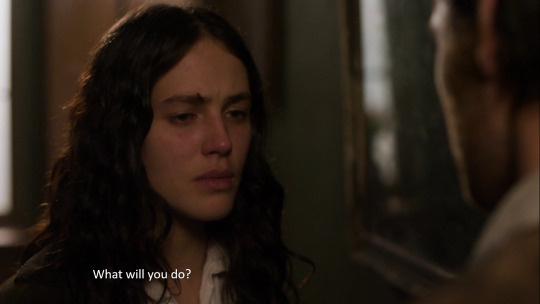
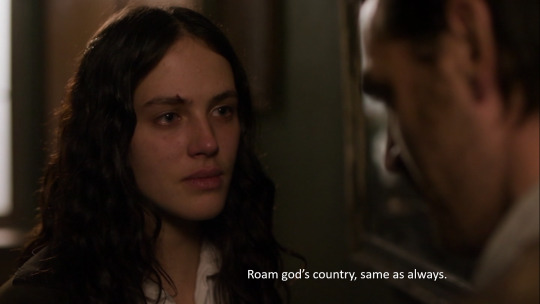

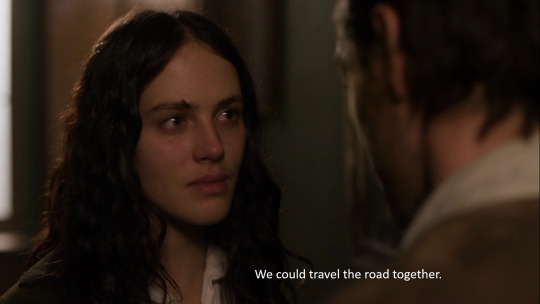


top five normal things to say during a breakup
#what if we just didn’t break the cycles of trauma?#daphne du maurier#classic lit#jamaica inn#if only this adaptation had more book accurate scenes like this one
4 notes
·
View notes
Text
all the time, gotta walk away, for a moment, take a break, infuriated, when reading about European implementation of forced labour, particularly and especially thinking about nineteenth and early twentieth centuries plantations, whether it's sugarcane or rubber or tea or banana, whether it's British plantations in Assam or Malaya; Belgian plantations in Congo; French plantations in West Africa; Dutch plantations in Java; de facto United States-controlled plantations in Haiti or Guatemala or Cuba or Colombia. and the story is always: "and then the government tried to find a way to reimpose slavery under a different name. and then the government destroyed vast regions of forest for monoculture plantations. and then the government forced thousands to become homeless and then criminalized poverty to force people into plantation work or prison labor." like the plantation industries are central (entangled with every commodity and every infrastructure project) and their directors are influencing each other despite spatial distance between London and the Caribbean and the Philippines.
and so the same few dozen administrators and companies and institutions keep making appearances everywhere, like they have outsized influence in history. like they are important nodes in a network. and they all cite each other, and write letters to each other, and send plant collection gifts to each other, and attend each other's lectures, and inspire other companies and colonial powers to adapt their policies/techniques.
but. important that we ought not characterize some systems and forces (surveillance apparatuses, industrial might, capitalism itself) as willful or always conscious. this is a critical addendum. a lot of those forces are self-perpetuating, or at least not, like, a sentient monster. we ought to avoid imagining a hypothetical boardroom full of be-suited businessmen smoking cigars and plotting schemes. this runs the risk of misunderstanding the forces that kill us, runs the risk of attributing qualities to those forces that they don't actually possess. but sometimes, in some cases, there really are, like, a few particular assholes with a disproportionate amount of influence making problems for everyone else.
not to over-simplify, but sometimes it's like the same prominent people, and a few key well-placed connections and enablers in research institutions or infrastructure companies. they're prison wardens and lietuenant governors and medical doctors and engineers and military commanders and botanists and bankers, and they all co-ordinate these multi-faceted plans to dispossess the locals, build the roads, occupy the local government, co-erce the labour, tend the plants, ship the products.
so you'll be reading the story of like a decade in British Singapore and you're like "oh, i bet that one ambitious British surgeon who is into 'economics' and is obsessed with tigers and has the big nutmeg garden in his backyard is gonna show up again" and sure enough he does. but also sometimes you're reading about another situation halfway across the planet and then they surprise you (because so many of them are wealthy and influential and friends with each other) and it'll be like "oh you're reading about a British officer displacing local people to construct a new building in Nigeria? surprise cameo! he just got a letter from the dude at the university back in London or the agriculturalist in Jamaica or the urban planner from Bombay, they all went to school together and they're also all investors in the same rubber plantation in Malaya". so you'll see repeated references to the same names like "the British governor of Bengal" or "[a financial institution or bank from Paris or New York City]" or "[a specific colonial doctor/laboratory that does unethical experiments or eugenics stuff]" or "lead tropical agriculture adviser to [major corporation]" or "the United Fruit Company" and it's like "not you again"

#tidalectics#my writing i guess#archipelagic thinking#multispecies#plantations and plantationocene#ecologies
324 notes
·
View notes
Text

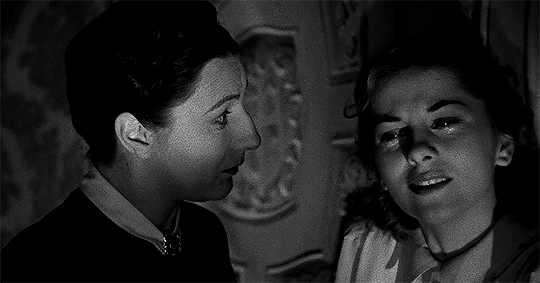
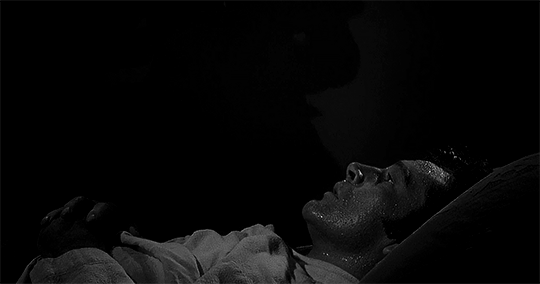


CLASSIC ADAPTIONS OF DAPHNE DU MAURIER:
Jamaica Inn (1939) dir. Alfred Hitchcock
Rebecca (1940) dir. Alfred Hitchcock
My Cousin Rachel (1952) dir. Henry Koster
The Birds (1963) dir. Alfred Hitchcock
Don't Look Now (1973) dir. Nicolas Roeg
#daphne du maurier#classicfilmsource#classicfilmedit#fyeahmovies#filmgifs#moviegifs#cinemaspast#filmsource#rebecca#jamaica inn#my cousin rachel#the birds#don't look now#horroredit#my gifs#gif#*
178 notes
·
View notes
Text
youtube
Black Cake | Official Trailer | Hulu
The story takes place in Jamaica, Rome, Scotland, England and Southern California. Cerar wrote the adaptation and serves as showrunner on the series, which spans decades. In the late 1960s, a runaway bride named Covey disappears into the surf off the coast of Jamaica and is feared drowned or a fugitive on the run for her husband’s murder. Fifty years later in California, a widow named Eleanor Bennett, loses her battle with cancer, leaving her two estranged children, Byron and Benny, a flash drive that holds previously untold stories of her journey from the Caribbean to America. These stories, narrated by Eleanor, shock her children and challenge everything they thought they knew about their family’s origin.
Based on The New York Times-bestselling book by Charmaine Wilkerson, “Black Cake” is a family drama wrapped in a murder mystery, from Marissa Jo Cerar, Oprah Winfrey’s Harpo Films, and Aaron Kaplans’ Kapital Entertainment.
Watch Black Cake on Hulu!
#Black Cake#Charmaine Wilkerson#series trailer#Ashley Thomas#Chipo Chung#Adrienne Warren#Mia Isaac#Youtube
101 notes
·
View notes
Text

Florida Occidental (Wattpad | Ao3 | CH HHM Oneshots)
Florida knew he should be more upset about becoming a British colony—about being taken away from his family and shoved into an environment in which he knew nobody.
Sure, Santiago had become British, but that was long ago, and Florida was sure that his prior identity as Santiago had been all but erased from his mind.
He was happy to escape his Padre’s overbearing, perfectionist nature, the never-ending stream of insults and jeers towards the imperfections that made Florida the failure he was.
He wondered if his Padre and Abuelo would even miss him. Surely, Padre would be happy that his children looked a little more perfect with Florida gone. He just hoped that Gran Bretaña would be kind to him, more accepting of Florida’s imperfections, or at least passing them off as a result of his Spanish heritage.
Although, based on how Gran Bretaña ignored Florida, focusing only on the French Colonies, it seemed that Florida might get off lighter and be looked at less closely as Gran Bretaña monitored the children of his most hated enemy.
Florida was often left alone, not yet ordered to bow at Gran Bretaña’s and forsake his family for the empire he was now a part of.
He realized why a few months after moving in.
He was ordered to Gran Bretaña’s room by the Thirteen Colonies, the colony that was supposed to be teaching him English. Florida had suddenly known it when the British took control, but now Thirteen Colonies mainly helped him by perfecting his grammar and getting rid of his accent, all flaws Gran Bretaña wouldn’t allow.
After seeing what Gran Bretaña did to the colonies that annoyed him, Florida was eager to get rid of it.
The pressure of perfection had returned. Although Thirteen Colonies was much kinder than Florida’s Padre had been. It was…it was nice.
But when Gran Bretaña ordered Florida to his office, Florida was scared about what that meant. Had he not been perfect enough? Had Gran Bretaña learned of Florida’s horrible imperfections from his Padre or Abuelo?
“Hello, señ—sir. You wanted to speak with me?” Florida asked, trying his best to focus on appearing normal and speaking English.
“Yes, I did. I know we have not spoken much since your arrival, and I wanted to apologize for that. The French colonies and their disloyalties have kept me busy ensuring they understand where their loyalties now lie,” Gran Bretaña explained with an apologetic smile.
“I understand,” Florida answered.
“And I thank you for that. I see your lessons with my son have been going well. It is nice to see you adapting so quickly. Now, I figured it was about time we established the relationship that would exist between us.” Gran Bretaña said. Florida was quick to bow his head, a habit long ingrained into him by his father.
“If you want to become my father, I am willing and ready to disown my Spanish family to become a true part of your empire,” Florida recited the lines he had come up with and practiced for ages with Thirteen Colonies to ensure that he said them correctly and, of course, perfectly.
“Thank you for your willingness, but I’m afraid I cannot accept that,” Gran Bretaña said. Florida froze, horror running through him. Did that mean what he thought it meant? Was Gran Bretaña planning on killing him?
“I accept your judgment,” Florida responded, trying to keep the fear from his voice. It didn’t work, as he could tell that Gran Bretaña had picked up on it.
“Do you think I’m going to kill you?” Gran Bretaña asked, sounding confused. Florida shrank in on himself.
“I understand why you would. I’m a—”
“Florida, you aren’t going to die. Trust me. Jamaica is…actually, I’m not sure if he’s your brother, but he was Spanish too, and he and I are close. I don’t want you to die. I believe that you can be a great addition to the empire. However, my government wishes to create a new colony from your preexisting land, and therefore…”
“Oh. We’re going to have a kid,” Florida realized. Gran Bretaña nodded.
“Yes. So I feel it is too awkward for you to call me father. However, if you feel it is beneficial to do a legal recognition, but not an emotional one, I can arrange that,” Gran Bretaña said.
“I would prefer not. I am loyal to you and only you, but I just do not want to…deal with complications from that,” Florida said. Gran Bretaña nodded.
“I understand completely. Now, I will call you back once I have fetched West Florida, who will be born sometime this week. Your new name will be East Florida, but you do not need to start using it until the new colony is born. I just wanted to give you an advance warning so you can start getting used to the name,” Gran Bretaña said, smiling again.
“Thank you,” Florida said, his voice tinged with relief.
“You’re welcome. Thank you for being understandable. You are shaping up to be a good colony.” Gran Bretaña said.
Florida couldn’t help but smile. It was nice to know that he was wanted.
#countryhumans#statehumans#oneshots by weird#countryhumans britain#statehumans florida#CH Hispanic Heritage Month#CH HHM 2024#CH Hispanic Heritage Month 2024
10 notes
·
View notes
Text

Call of Duty OC : Xochitl "Pidge" Magdalena Ortiz
Fiercely loyal, resourceful, and compassionate but also deeply guarded due to her traumatic past, Pidge carries a quiet strength, expressing herself more through action than words. Rescued by Captain Price as a teen, Pidge considers him a primary figure in her life and credits him, alongside Alejandro Vargas, for shaping her into the soldier she is today, making her a formidable addition to taskforce 141.
General:
Name: Xochitl Magdalena Ortiz
Alias: "Pidge" (given to her by Captain Price)
Date of Birth: September 16, 1994
Age: 28
Height: 5'6"
Weight: 210 lbs
Blood Type: AB
Race/Ethnicity: Latina
Country of Origin: Mexico
Affiliation: Mexican Special Forces (Fuerzas Especiales), Task Force 141
Rank: Sergeant
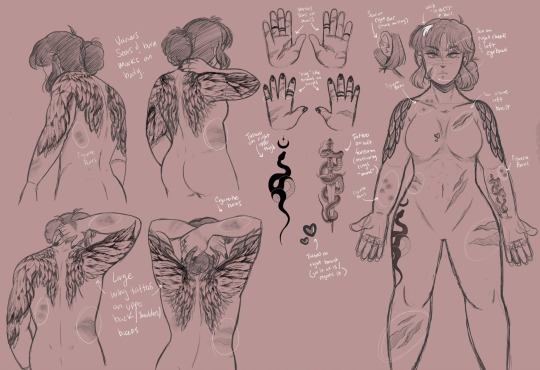


Appearance:
Eye Color: jade green
Hair Color: raven black
Height: 5' 6" (167 cm)
Scars: (pictured above) Xochitl has various scars from her time in the fighting ring, most notably her hands, as well as others around her body from her time on the field.
Tattoos: (pictured above) Her most notable tattoo is the large pair of wings accentuating her mid back and shoulders.
Build: Athletic with a sturdy, muscular frame, reflecting her strength and agility
Fancast: Stephanie Beatriz
Favorites:
Color: sunset orange
Food: pozole
Drink: agua de jamaica and black coffee
Flower: marigold
Pastimes: boxing, weightlifting, smoking, journaling
Skills and Abilities:
Preferred weapon(s): Sniper rifle
Special skills: Close-Quarters Combat (CQC) Pidge is swift and calculated, using her smaller stature and agility to outmaneuver larger opponents. With a combination of joint locks and throws, she incorporates techniques to disarm or disable opponents quickly, using their momentum against them.
Fighting style: Strong foundation in hand-to-hand combat and situational awareness.
Survival Instincts: Her experience surviving extreme hardships as a child honed her ability to adapt to unpredictable situations. Relies on quick reflexes, creativity, and unconventional tactics.
Boxing and Kickboxing: Uses sharp, deliberate punches and low, sweeping kicks to destabilize opponents.
Krav Maga Influence: Practical techniques aimed at disarming, disabling, or neutralizing threats efficiently.
Focus on Pressure Points: Targets vulnerable areas like the throat, knees, and ribs for maximum impact.


Personality:
Myers Briggs Type: ISFJ (The Defender) Pidge is naturally reserved and introspective, often communicating more through her actions than words. She tends to keep her emotions and thoughts private, relying on a small circle of trusted individuals. She can also be highly detail-oriented, practical and grounded, focusing on the present moment and the tangible realities of her missions. Her sharp observational skills allow her to read her environment and the people around her with precision.
Deeply empathetic and loyal: prioritizes the well-being of her loved ones and teammates. Her moral compass is strong, guiding her decisions and actions even in the harshest circumstances. She shows compassion, particularly towards vulnerable individuals like young children.
Adaptable Under Pressure: Although she prefers structure, her military training and survival instincts enable her to remain calm and resourceful in unpredictable situations.
Negative Traits:
Emotional Guardedness/Struggles with Vulnerability: Pidge often hides her deeper emotions, fearing judgment or being perceived as weak.
Difficulty Asking for Help: Her self-reliance sometimes prevents her from seeking support, leading to unnecessary stress or burnout.
Stubbornness: While her determination is usually a strength, it can turn into inflexibility, causing her to push herself or others too hard.
Residual Trauma: Due to her traumatic past, Pidge is constantly on edge, always scanning for potential threats. While this is useful in her line of work, it can also prevent her from fully relaxing or enjoying peaceful moments.
Tendency to Bottle Emotions: When she suppresses her feelings for too long, Pidge might have sudden emotional outbursts, which can catch others off guard. She tends to internalize negative emotions, letting them fester rather than addressing them head-on.

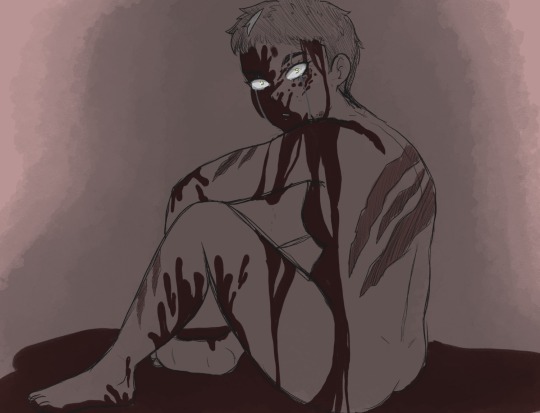
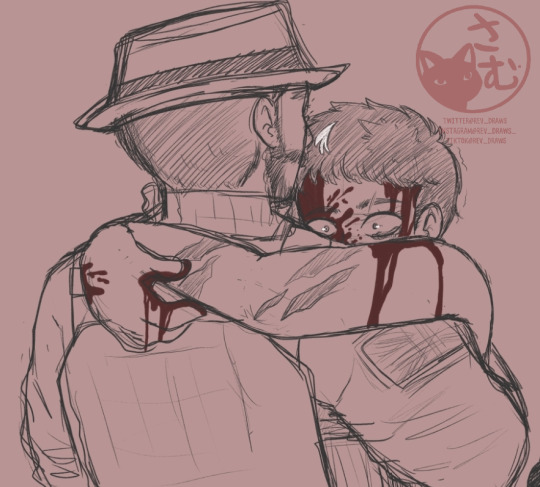
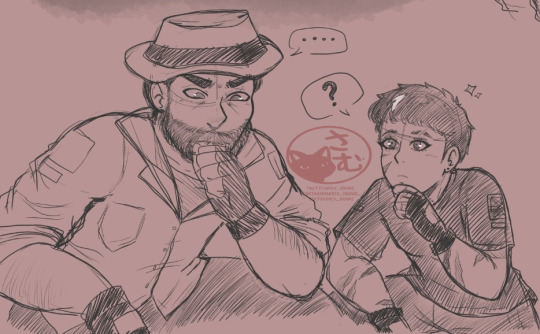
Background Story:
Born in a small village in Mexico, Xochitl’s early years were marked by tragedy and hardship. With her hometown overrun by rising cartels, she was caught in the crossfire of many rival gangs, taken by a human trafficking ring and was subjected to unimaginable abuse. As part of an underground fighting ring, Xochitl was forced to fight and survive, her combat skills sharpened at the cost of the many young lives she had to fight against.
The underground fighting ring turned children into killers. Every week, the cartel ran gambling rings on their "fighters"—children pitted against one another to the death. Xochitl learned quickly. The first fight nearly killed her, but the desire to survive burned brighter than the fear. At 16, she was rescued during a military operation led by John Price. Upon reaching the base of operations, it was unusually quiet. Price's team managed to find a cell filled with young girls, many of them weak and afraid, but still alive. With no sign of any cartel members, Price found it unusual, and went to investigate, only to find a horrific sight before him. Inside one of the darker cells, was the silhouette of a young woman, drenched and sitting in a pool of blood with the bodies of 4 cartel members surrounding her. With her back turned to him, he approached her quietly, but was met with a pair of jade green eyes, wide and seemingly cutting through the darkness. With heavy and ragged breaths, she revealed her name. Xochitl. After sitting with her for a few minutes, Price managed to gain her trust, freeing her from the house of horrors she grew fighting in. Price was baffled to see someone so young manage to take down 4 grown men on her own, saving the other young girls in the process. To him, she wasn't a monster. She was a hero. A fighter.
Though physically free, Xochitl struggled to trust others and rarely spoke. With no information on her family, Price took her under his wing instead of having her placed in some horrid orphanage, until she was 18, eventually joining the Mexican Special Forces (Fuerzas Especiales), under the guide of Colonel Alejandro Vargas, earning recognition for her unmatched skill set and loyalty.
After 10 years, Xochitl became a formidable member of the Mexican Special Forces, reaching the ranks of sergeant. Her jade eyes continue to carry the many lives she had taken all those years ago. With her expertise behind the scope and her close combat skills, she keeps her team safe by keeping a keen watch from above. As the events in Las Almas, Mexico unfold, Xochitl becomes a close ally to Ghost and Soap, earning mutual respect from each other. With her intimidating silence and quiet movements through the shadows, it wasn't long until Ghost began to grow intrigued by her sheer determination.
Trivia:
According to Captain Price, Xochitl had often prayed to God as a child, asking to be turned into a bird so she could fly far away, thus earning her the name "Pidge."
Price has also stated that she was quite the troublemaker, oftentimes getting into trouble and even having to bail her out of a Mexican Prison
True to her callsign, Pidge has an uncanny habit of finding high vantage points (trees, high rise buildings, etc.) whether in combat or just to think.
Pidge is terrified of severe storms, a result of her traumatic childhood. She also has an irrational fear of moths.
Pidge is afraid to close her eyes in the shower.
Pidge sometimes plays guitar and sings, but does it in private.
Pidge has an uncanny ability to fall asleep anywhere, no matter how uncomfortable it may seem.
Before every mission, she silently prays for her teams safety while holding her cross necklace.
Notable Quotes:
"Sometimes, all we need is a little freedom to soar."
"A bird in a cage is still a bird, but one that fights to fly... that's me."
"I’ve faced monsters before. They taught me how to be one—but I choose not to be."
----------------------------------------------------------
Credit to @sleepyconfusedpotato for the format inspiration 💖
#call of duty#cod#modern warfare 2#cod mw2#call of duty oc#cod oc#original character#captain price#john price#simon ghost riley#simon riley#call of duty ghost#ghost call of duty#cod ghost#oc x csnon#call of duty original character#oc profile#task force 141#tf 141#ghost x oc#task force 141 oc#Ghost x Pidge#my art#rev art
12 notes
·
View notes
Text
The Black History of No Doubt 🖤🤍
In 1986, Eric Stefani and John Spence met and bonded over their love of the anti-racist UK ska movement while working at their local Dairy Queen.
With John on lead vocals and Eric on keyboard, they formed Apple Core. Which was later changed to No Doubt after Spence’s frequent use of the term became an inside joke for the group.

John Spence (Traci Vicars Brown)
This catchphrase also spawned an early track of the same name with Eric’s little sister Gwen Stefani and John Spence on vocals.
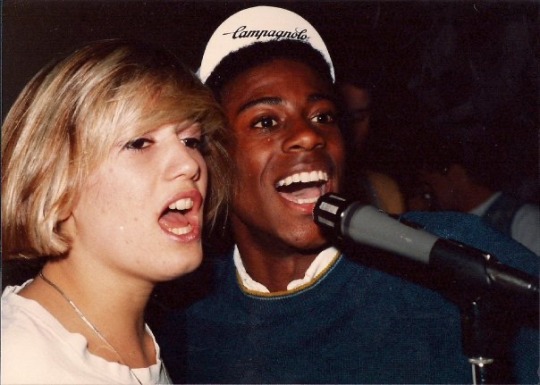
Gwen Stefani and John Spence (Traci Vicars Brown)
Spence was most notably known amongst early No Doubt fans for his infectious energy and on-stage back flips. Wherever Spence went, the rowdy youth of Orange County followed.
In the lead up to one of their biggest shows yet, the members of No Doubt were blindsided at the news of Spence’s untimely death.
On December 21st, 1987, John Spence had passed from a self inflicted gun wound at just 18 years old.
The band was devastated and played their show at the Roxy as a final goodbye, not only to John, but to the band he had co-created.

Early No Doubt Lineup Featuring John Spence
However, after deep thought and a break from the music, they ultimately decided that in the spirit of John and his love for music, that they’d continue on. Their first song without Spence being a tribute titled “Dear John”
“You're singin' in a band with a mic on in your hand
The way that you would sing really made me feel all grand
You left your friends alone, right upon this earth
I wish you would've seen how much life was worth…”
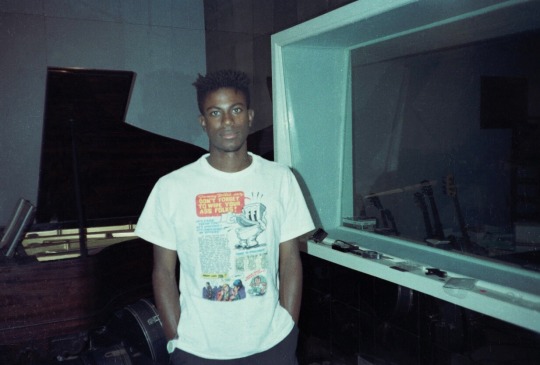
John Spence (Eric Keyes)
With Gwen Stefani still too timid to take over full time, trumpet player Alan Meade stepped up to take the space John Spence had once occupied.
Like Spence, Meade became quickly know for his amazing stage presence and spirit. With Meade and time, Gwen Stefani began to break out of her shell.

Alan Meade and Gwen Stefani
Although often mistaken for Spence in images and videos of live performances, Meade was so much more than simply a “replacement” for Spence.
Much of Gwen’s later vocalizations are adaptions of Meade’s choices in demo tapes of songs such as “Boucing Shoes”, “Get A Life”, and “Doormat” to name a few.
Another black performer that deeply influenced Gwen’s vocal style was ska icon and lead singer of The Selecter, Pauline Black
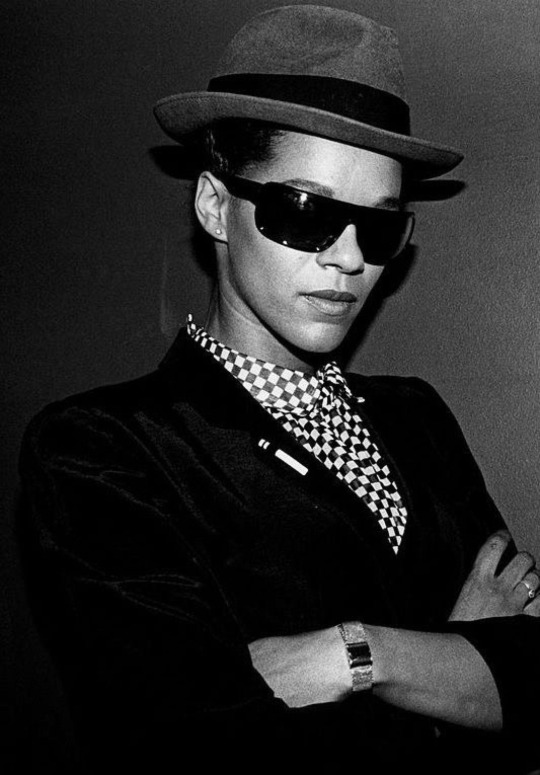
Pauline Black of The Selecter
Alan Meade’s time as the lead singer of No Doubt was short lived as the news of his then girlfriend’s teen pregnancy in 1988 led to his departure. He left the group to focus on his family, yet would regularly make surprise appearances at their shows and perform with them for a song or two.
The members of No Doubt and Alan Meade have stayed connected throughout the years and he eventually went on to join members of Save Ferris in the creation of a new ska group known as Starpool.

Gwen Stefani and Alan Meade during the Tragic Kingdom Era
In the early 90’s, Gabrial McNair and Stephen Bradley would join No Doubt as backing vocals and the “horn section” of the final lineup.
McNair and Bradley, often seen as a team, have maintained their musical relationship with Stefani the longest out of all the other members of No Doubt.

1998 MTV Music Video Awards
Being a part of her backing artists since the early 90’s with No Doubt and through all of her solo efforts as well.
The pair still performs with her to this day and are often not included in descriptions of No Doubt’s lineup, but all fans know that they are just as vital as the rest of them to the band’s massive success.
Gabrial McNair has also toured with Green Day, co-founded Olso in 2005, composed music for film & TV, and worked with multiple artists in-studio.
Stephen Bradley too has toured with Green Day, Smashing Pumpkins, and Steel Pulse. He has also released solo work and is a talented photographer/videographer as well.
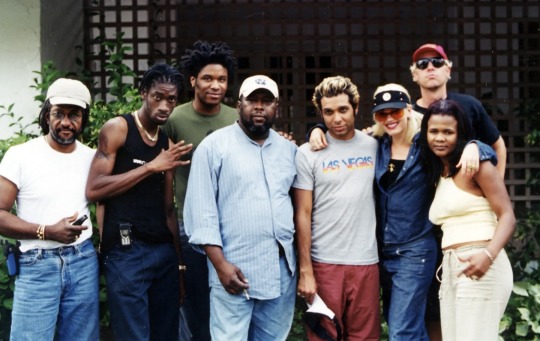
‘Rock Steady’ Jamaica Recording Sessions Crew
For their fifth album, Rock Steady, the band desired a Jamaican dance hall inspired sound, collaborating with numerous local artists/legends.
Including Bounty Killer, Lady Saw, Sly Dunbar, and Robbie Shakespeare (Sly & Robbie), to name a few.
This also marked the beginning of a lifelong musical partnership and friendship between Pharrell Williams (of The Neptunes at the time) and Gwen Stefani.
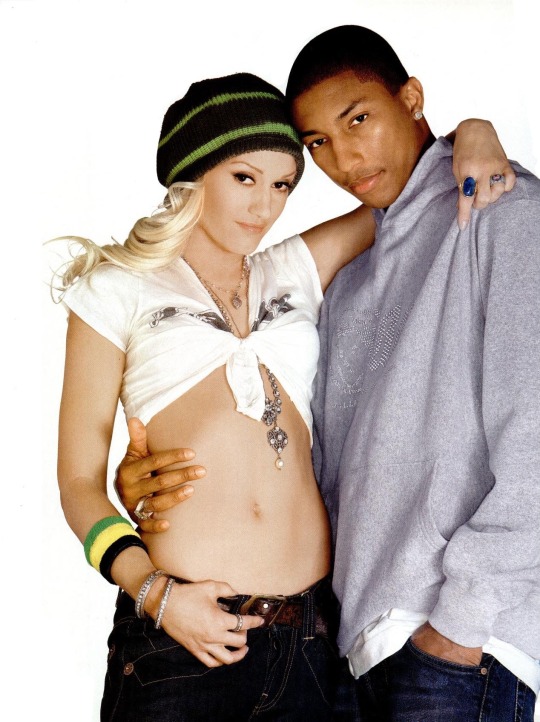
Gwen Stefani & Pharrell Williams for Vibe Magazine 2005 (Albert Watson)
In addition to the impressive list of collaborators on Rock Steady, the band also worked with one of Stefani’s greatest inspirations and favorite artist, Prince.
In the same year, she got to return the favor and provide backing vocals on his 2001 track “So Far, So Pleased”
“He was such a genius that you can’t believe he existed. I was onstage with No Doubt in Minneapolis in the Nineties, and I saw his silhouette in the audience. I was like, ‘How is this happening?’”
Gwen Stefani on Prince, Rolling Stone Magazine 2016
Since the band’s initial breakup, Stefani has collaborated with artists like Eve, Dr. Dre, Saweetie, Fetty Wap, Slim Thug, Andre 3000, Snoop Dogg, Akon, and most recently Shenseea on Sean Paul’s “Light My Fire”
Without the insurmountable talent of all of the artists covered in this post, No Doubt would not be the band it is today. The influence Black musicians have had on members of the band (of all racial backgrounds) is evident in their discography and should be recognized.
I wrote this post in hopes of highlighting the often forgotten side of No Doubt and to celebrate Black History Month, but every month is a good month to recognize Black excellence :) Thanks for reading!
#no doubt#no doubt band#john spence#alan meade#gabrial mcnair#stephen bradley#pauline black#bounty killer#lady saw#sly & robbie#pharrel williams#pharell#prince#eve#dr. dre#snoop dogg#akon#fetty wap#slim thug#andre 3000#saweetie#shenseea#black history#black history month#gwen stefani#tom dumont#tony kanal#adrian young#the selecter#save ferris
20 notes
·
View notes
Text
Could Izzy be Jewish? Some meta about the name Israel in the context of 17th/18th century English customs.
While I am perfectly fine with all kinds of headcanons behind Izzy's name, as an onomastics (the linguistic study of names) enthusiast and a philologist, I have to throw my hat into the ring. Let me tell you a bit more about the name in the context of English language itself. The canon does not tell us anything about Izzy's religious background, so I thought I'd spam you with some linguistic and historical knowledge lol.
Most people automatically connect the name Israel with the state of Israel, and it is, of course, a correct connection, as the name is the same in terms of etymology. The name is Hebrew and comes from the Book of Genesis. As a first name, it is ancient, as it was proven to have appeared on Eblaite language cuneiform tablets (on the lands of modern-day Syria).
However, we need to take into account that Israel Hands was born in the 18th century, when the naming customs were different from the BCE ones.
The most common naming custom in 18th century England was naming children after other family members - often the first son was named after the father's father, and the second son after the mother's father. The third son was named after the father himself. Of course, not every family followed that tradition, and sometimes (as it was a case with Stede) parents chose more unusual names.
Ever since the 10th century the Old Testament Hebrew names were popular in the Celtic areas of the world, with historical figures such as Israel the Grammarian bearing the name whilst having strong ties to the Latin Church.
In the late 1600s and 1700s England was predominantly Protestant, with the Church of England being the "default" church of the English people. However, the Anglicans of that era tended to identify their practices and traditions with Jewish ones over Catholic ones, as the Anglicans considered themselves to be one of the Ten Lost Tribes of Israel. Puritans and many other non-conformist dissenters (Protestants not agreeing with the CoE) especially liked to give their children names from the Old Testament and often chose the Hebrew spelling. Puritans also adapted some of their religious customs from Jews.
Jews began to resettle in England in the 1650s (after being expelled and banned by king Edward I in 1290 with the rise of antisemitism in the kingdom) but by the 1700s their numbers were still very low in comparison with Protestants. In 1690 their number was reported as barely 400.
However, there are historical reports of larger numbers of Jews (many Dutch of Portuguese Sephardic Jewish origin like Moses Cohen Henriques) in Jamaica in that time, especially in Kingston.
Biblical names were usually given by religious families - among the most popular were Benjamin, Isaac and Abraham. Less religious people and royalists often chose names connected to the historical English royals (like William, Edward, or Henry).
It is also worth noting that Israel might have not been the real name of the historical pirate - in 1719 he is referred to as Hesikia (Hezekiah) Hands.
So, to sum up: From a linguistic point of view, having the name Israel does not simply imply that its bearer comes from a Jewish family or is Jewish themself. As the Hebrew names were extremely popular amongst the dissidents that fled England to avoid religious persecution and ended up in America, it is very likely that the historical Israel Hands came from such a family. There is no historical information about his place of birth, though, so he might have been born in Jamaica.
As for the OFMD's Izzy Hands? We have absolutely no idea - his austerity and stark personality, as well as the tendency to dress all in black, might suggest Puritan upbringing, but since we were not told anything explicitly, you can all safely create your own headcanons without offending anyone, I believe. While the historical pirate likely wasn't Jewish, OFMD mostly avoids the topic of religion altogether (except for Jim's case), so the fans are free to interpret the characters in a way they enjoy.
This post was meant to be a "fun fact" type of a post, giving some background to the name itself in the context of English language and culture. I am neither Jewish nor Anglican, but I am an academically educated philologist obsessed with the etymology and names.
I might write the next post about the name Stede, as it is quite a curious case.
#i just like names okay#izzy hands#israel hands#our flag means death#ofmd#ofmd meta#ofmd meta post#ofmd headcanon#you cant stop a philologist from overanalyzing language stuff#etymology#onomastics#english philology freaks and all
123 notes
·
View notes
Text
Some incomplete and perhaps incoherent thoughts on class, race, personhood and women’s sexuality; Tom Jones (2023) in conversation with Fielding’s text
Warning: spoilers for The History of Tom Jones, a Foundling and Tom Jones (2023)
I’ve been thinking about the changes to Sophia’s story and how they both serve to add dimension to her character and to engage with existing themes of the text in complex ways. In Fielding’s text, Sophia is the white English-born daughter of Squire Western and the offspring of a “legitimate” (but very unhappy) marriage. In the 2023 adaptation, she is Squire Western’s granddaughter, born in Jamaica as the offspring of a non-consensual union between her white slaver father (Squire Western’s son) and her Black mother Beneba. She, like Tom, is a bastard, but she has been legitimized, given her father’s name, and declared sole heiress of her family’s fortune.

These changes don’t make Sophia’s storyline easier to witness — her arc is essentially about violence and the erasure of women’s wills by society, and they now include a racialized component as well. Sophia and Honour experience racial prejudice and harassment while fleeing to London, and Sophia’s entrapment and abuse by Lady Bellaston involves racialized as well as sexual violence, as Lady Bellaston quite literally tries to whitewash her. To make these moments land, the adaptation has endeavored to strike a tonal balance by giving the narrative voice of the story to Sophia herself, consistently framing the action through her gaze, and allowing appropriate space and gravitas for the injustice of her imprisonment and assault. They’ve also explored the text’s existing themes of class, personhood, and women’s sexuality within this new context.
In as much as it is possible to attribute prescient thematic points to the sort of madness Fielding was writing, there is an ongoing critique throughout the text about the artificial construction of personhood based on class, and particularly the relationship between class and women’s sexuality. Even in the novel, both Tom and Sophia are subject to conditional personhood — Tom due to his status as a low-born bastard, and Sophia due to her status as a woman. But this parallel takes on new meaning in the adaptation. Sophia’s new backstory means that now both lovers have been “rescued” from the conditions of their birth by benefactors to whom they owe their gratitude: Sophia to the grandfather who brought her across the ocean, Tom to his adopted father Squire Allworthy, who raised Tom as his son but never as his heir. Of course, both Tom and Sophia are betrayed by these benefactors as soon as they fail to meet the requirements of their conditional personhood. I appreciate how this adaptation brings attention to Allworthy’s hypocrisy as well as Squire Western’s, as it makes the parallel more coherent. It’s because of this conditional personhood that Tom and Sophia are even able to fall in love in the first place — all those intimate hours together are only allowed because Squire Western doesn’t fundamentally see either of them as full people capable of their own wills.

Tom is marked from birth as less than a full person, by nature of his association with his “ruined” mother (a teenaged serving girl presumably impregnated by her middle-class master). His “base” nature is further reinforced by his continued association with other “ruined” women. His status as a gentleman (or lack thereof) is fundamental to his identity and entirely outside of his control. Whether by the manipulations of Mr. Blifil or the willful bias of others such of Allworthy, Tom’s actions are consistently interpreted in the worst possible light, cyclically upholding the assumption that he’s not a “proper” gentleman after all.
Of course, Tom still gets away with quite a lot (he is a handsome white man after all!), no more so than at the story’s finale, when he himself is legitimatized and all is forgiven, doubly proving Fielding’s point. If it feels contrived that Squire Western should immediately and inexorably reverse his opinion on Tom as a match for Sophia, it’s because it is contrived. Squire Western’s refusal of Tom never had anything to do with his personality, charm, sentiment towards Sophia, or personal honor, but merely his lack of sufficient legal personhood to match Sophia’s. It’s a frustrating feature of the story that in order to deliver Tom and Sophia to a happy ending, Fielding must in the end uphold the very systems he spent much of the novel’s breadth critiquing. However, I do believe it’s meant to land with some irony. And there are some nice touches to Fielding’s execution of the twist — for instance, that Tom’s legitimacy comes from his relationship with his mother, not his father, who in fact does not matter at all.
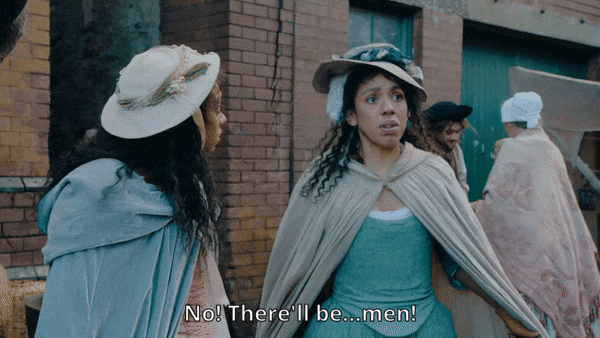
Of course, Sophia’s arc is also very much about the relationship between personhood, class, and sexuality. She has the status of personhood by virtue of her wealth, but keeping it is dependent on her consenting to marry within her own class. Her sexuality is so constrained and controlled that her desire for Tom is described by Aunt Western as “monstrous inclinations” and is at one point compared by Squire Western to beastiality. To marry Tom would mean relinquishing her own claim to personhood, a fate so unthinkable that neither Sophia nor Tom ever seriously consider it beyond a few passionate outbursts. When Sophia flees Somersetshire, she is not running to elope with Tom, only to buy herself more time to make Squire Western see sense and hold off her marriage to Blifil.

There’s a certain aspect of this drama that is a bit hard to buy, especially for modern readers. Sophia is an heiress — she’ll inherit her own wealth. She’s in love with Tom, who is one of her father’s dearest friends. Why can’t everyone be happy? Aside from the reasons stated above and the constraints on Sophia’s sexuality that exist already in the text, the adaptation has added additional context. As a Black heiress, Sophia’s status as a legal person in English society is already so fragile that Squire Western and Aunt Western feel justified in acting to preserve that personhood by any means possible — namely, by securing her marriage within her class against her will. In the show’s first episode, Squire Western says to his sister: “My girl is beautiful and she is rich. Who cares if she be Black and a bastard too?” to which Aunt Western replies, “Good lord, Brother. The world may care rather a lot.” The fact that this personhood does not include the right to consent is already explored in the novel, but the adaptation includes the arc of Sophia grappling with the knowledge and grief that her mother died while enslaved.

The relationship between Sophia and Squire Western is one of my least favorite parts of the novel, but the changes to Sophia’s backstory add some additional context and complexity, and some careful tonal choices go a long way. It makes sense, after all, that Sophia would feel some devotion for her doting grandfather, her last family member not bound by lived experience to her memories of Jamaica and her slaver father. At the same time, the adaptation never minimizes the fact that Squire Western still sees Sophia as a form of property — the granddaughter he brought across the ocean at great expense, the last living reminder of his slaver son. In some ways, they’ve made him less awful — he’s certainly less explosively violent than he is in the novel, wherein he hits Sophia, verbally abuses her to a much more intense degree, and regularly threatens her with death. But the implicit violence of his banal small-mindedness is not erased.

Aside from the issue of Sophia’s forced marriage, which is cut-and-dry violence, their relationship seems to evoke some of the painful and complex dynamics that can arise from interracial adoption. Squire Western declares himself to love and cherish his perfect, beautiful Sophie, and Sophia has an honest experience of feeling loved by him, but ultimately, he doesn’t really understand her experience or her pain, and he makes no effort to.
Just as Tom’s happy ending must uphold the very systems that have oppressed him, so too must Sophia’s. In the novel’s finale, Squire Western does not receive any comeuppance for his role in the drama, despite acting as much a villain to the lovers as Lady Bellaston and Mr. Blifil, both of whom receive their just desserts. Within the context of the story, there is no ending for Sophia wherein she disowns Squire Western and lives out her days as an independently wealthy woman. Her happy ending can only exist when her will and Squire Western’s will align, which is made possible by the novel’s final twist. In the end, Sophia must live with the complexity of her relationship with Squire Western, not overcome it. I’ll let you decide how you feel about the adaptation's handling of that. I��m still not sure how I do.
I can never get to the end of this story without wanting to write fic about it, specifically about Sophia’s trauma, and how that might impact her relationship with Jones and with Squire Western going forward. I wrote fic about it when I finished the book and I’m writing fic about it now in the context of the show’s canon and characters. In some ways, the ending leaves more questions for me than it leaves neat conclusions. Whether that’s a strength of the story or a weakness is, I suppose, a matter of taste. The adaptation put a lot of love into rendering Sophia’s arc and illustrating her experience in this 18th-century world. It centered her voice and her gaze as much as possible, and it gave the spotlight to Sophie Wilde’s performance, which is the ultimate heart of their story. For all of those reasons, I appreciate it as an example of race-conscious historical drama and as an adaptation engaged in post-colonial dialogue with the English literary “canon.”
Whether it ultimately succeeded in giving Sophia all the justice she deserved, I’ll leave to voices other than my own.
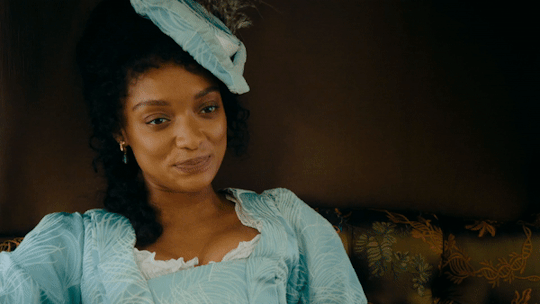
#tom jones#tom jones pbs#tom jones 2023#the history of tom jones#sophia western#tom jones itv#henry fielding#tom jones meta#my meta#oh im anxious about posting this one#just a lot of thoughts and feelings and always the doubt whether im the right person to express them#but of course i am very open to good faith discussion about any and all of this
50 notes
·
View notes
Text
Review of Migration (2023)
Hey, Cassipedia, what’re you watching?
Over the weekend, I watched the film Migration. It is an original animated film directed by Benjamin Renner and co-directed by Guylo Homsy and produced by Illumination. When I say original, I do mean it, as it is the first movie I’ve seen in a while that is not an adaption nor based on a pre-existing property.
Do you recommend watching it?
Yes, very much so! This was a surprising experience that I would hate for others to miss out on. The commercials had piqued my interest with the beautiful animation of the flying scenes and the jokes seemed harmless enough. Sometimes I am wary of Illumination films as they can be sometimes a bit too noisy or chaotic, but I’m very glad I saw the movie anyways, as it was surprisingly heartwarming, very cute and stunningly gorgeous (and, contrary to my concerns, it actually uses quiet moments better than most animated films I’ve seen recently!)
What's the story like?
This is a story about the Mallard family, ducks that live a peaceful and simple life in their pond, until a flock of migrating ducks stirs an adventurous itch in everyone except the nervous father, Mack. However, he soon comes around to the idea as he realizes how much an adventure would mean to his family and especially his wife Pam. So they start flying to Jamaica for a vacation. The trailers for the movie spoils the fact that the ducks take a wrong turn and end up in New York City, but the story is less focused on ‘duck shenanigans in an unfamiliar place’ and it instead is more of a road trip with a seamlessly integrated villain. This road trip allows the Mallard family to see different locations and meet different birds, all the while the family grows closer, trusting each other and growing braver in their own ways. There are delightful moments of silliness that are reminiscent of Looney Toons, but the movie takes seriously how much the family loves each other, giving them a reason to grow together as strong and beautifully as the trees they fly over.
What does the movie look like?
Think of how beautiful the sky is. Have you ever been on a plane and looked out at the sloping mountains and pillars of white clouds? Or perhaps, as the sun sets, you look up see how the red sun fades into golden orange blanketed by increasingly purple clouds and the approach of blue night? This movie understands how beautiful the sky is and elevates that feeling, as our bird characters soar and fly through vibrant forests, to a claustrophobic but intriguing water-logged shed, to the shiny and colossal skyscrapers of New York. The settings are gorgeous and the characters themselves are animated masterfully, so each character is incredibly expressive, with the beauty and grace of real-life birds mixed with Muppets-style comedic timing and cartoon stretchiness anchored by being able to carry heavy emotions. This all goes hand-in-hand whenever the birds take flight, as the camera seamlessly follows the birds from take-off to being air born, giving the thrill of a flying rollercoaster. There is such a sense of scale and height, and the world is from the birds’ perspective, with little details that brought me back to the creativity of early Pixar, such as having the father duck blow away a lightning bug nightlight like blowing out a candle, or how the birds will seamlessly alternate between their wings or their feet to gesture. With the movie being from the perspective of the birds, that means none of the human characters talk, being more like creatures existing alongside the bird characters, and this results in a very entertaining and interesting villain in the form of a duck chef with a Yakuza, gang member level of intimidation, whom never utters a word beyond grunts and yells paired with very well-made expressions. To give an idea of how good the animation is, even though the chef has no lines, from simply how he moves, sharpens his knives and looks at the ducks, one can see how, he’s a chef that takes his cooking very seriously, demanding high quality, but, when the ducks start interfering with his business, then he’s all too happy to start seeking revenge. And he is technically only a fun obstacle as the core of the story that this beautiful movie conveys is not about them versus a villain, but instead focused on a family.
How are the actors and actresses?
Every voice perfectly fit their characters, and the animations did excellent in having it where I could feel the characters talking, watching how their beaks formed the words with little flashes of their pointed, bird tongues. The father Mack Mallard was voiced by Kumail Nanjiani and did excellent as an anxious father who could get silly and serious, (and whose manner of speaking fittingly reminded me of a more grounded Daffy Duck). Elizabeth Banks voiced Pam Mallard and delivered as a mother with energy and eagerness paired by a snappy quick wit and a genuineness in each word. One of the cores of this movie is seeing and hearing how Mack and Pam fall back in love with each other over the course of the film, and I believe these voice actors delivered. The rest of the family cannot be overlooked, as Caspar Jennings as Dax Mallard provides a great performance as a courageous young boy who is itching for adventure. Dax is full of bravery but lacks the knowhow on how to protect himself along with others, whereas his father Mack is an excellent survivor but needs to be urged out of his comfort zone to truly become brave. The lesson between them is not simply one is right and the other is wrong, but it is a sharing of perspectives, in which the boy’s bravery inspires the father, and the father’s wisdom equips the boy against their obstacles. I was most concerned of the family member Uncle Dan, voiced by Danny DeVito, as to if he would be an unpleasant tagalong as sometimes happens in these movies, but he quickly established himself as someone who, though he makes quips and seems to lean on his self-interest, he never, ever hesitates to dote on and play with his darling niece, the youngest Mallard, Gwen, who is voiced adorably by Tresi Gazal. Notably, the film makes a point to show that the family already loves one another at the start, but their trip lets them appreciate each other and push their boundaries and discover more of themselves. The other voice talent are more than just recognizable celebrity names and each fit their characters, providing a distinct and colorful cast as one would hope from a road trip type movie. The Herons were my favorites in setting the tone of characters not always being what they seemed in an intriguing way, but each played a role in furthering the family’s journey and usually closed their loop on their own personal journey. The only group of these characters that may feel underexplored are the migrating ducks that inspire the Mallards on their journey in the first place, but I think it is due to the other characters simply having more screentime, as I’ve no doubt these characters would have been just as entertaining as the rest of the cast if they had been given more time.
Is the music worth talking about?
This is not a musical, but the score is absolutely a big part in why the scenery and so many of the moments in this movie sticks out in my mind so vividly. If you listen carefully, you will hear how the music changes depending on the setting. While the Mallards are in the forest, there is an emphasis on using a whimsical choir, adding to the lighthearted feeling, and as they enter the city, unsure of what it even is at first, the music takes on an ethereal, almost dream-like quality that one isn’t quite sure what to make of, until the ducks pass through the smog and nearly run into a steel beam and suddenly you got energetic and chaotic brass instruments banging in as the Mallards are caught in a whirlwind of New York City hustle and bustle. My words really can’t do it justice. And it is worth noting, there is only one distinct instance of a pop song being used in the movie and it is incorporated quite well as a band in a scene plays that song, resulting in a surprisingly beautiful display of ducks engaged in a Salsa dance. The movie is very smart with its music, as it furthers the immersion of seeing this colorful world through these cartoon ducks’ eyes. There are also great moments of quiet and silence, as the movie will also let the atmosphere talk for itself, really letting you sink into it (though it is worth noting that, for the opening of the Universal and Illumination logos, these are the complete opposite and are the noisiest parts of the entire film as the Minion characters from Despicable Me introduce the logos with kazoos. And if you are watching the film in theaters, you may find yourself sitting a surprisingly long time watching a short film based in the Despicable Me universe called ‘Mooned’ but rest assured, you did not walk in on the wrong movie and I very much encourage you not to leave your seat as I overheard many others in the theater seats next to me nearly did.)
Who would like this movie most?
If you are someone that likes birds or the sensation of being high up in the air or on a rollercoaster, I very much urge you to check out this movie. It is also a film that I think would be very enjoyed by those whom are interested in animation and illustration, to see an excellent example of how colors and movement can truly be blended to dazzle in a movie format. The story and characters are well-written and compelling for any age, though I think this movie would be well-received by families, especially as this film strives to show how a family grows closer together. There is a clever, timelessness to the jokes that focus more on the situation on hand and when you have animal characters reflecting on human habits, such as when one of the birds refers to a chef as ‘a predator that hunts prey and serves it to much lazier predators.’ During one of my viewings of the film, I had the pleasure of a family of a broad range from the parents, to their parents to young boys all sitting near me, and it caught my ear that each generation consistently laughed throughout the course of the film.
Where can I watch it?
This film is available in theaters for only a little bit longer at the time of writing this, but I heavily recommend seeing it in theaters at least once. Not only so you can really soak in the colors and the scope of the heights as the birds fly, but also so you can better feel the thrusting of wings as the birds take to the sky and the wind rushes through their feathers. It is an incredible experience. Considering it is an animated movie, it is possible it may re-appear in theaters for kids movie special offers as theaters like the Marcus Theaters sometimes provide. Otherwise, if this review reaches you too late, the film is available for streaming on Peacock for the first four months of being released, then will move to Netflix for the next ten, and then will return to Peacock for the remaining four, so I recommend checking between those streaming services of Peacock and Netflix. Otherwise, it doesn’t hurt to keep an eye out for a physical copy.
Final thoughts?
Migration is a beautiful film that I think can very easily fit in as a classic film, one that focuses on bringing a family together through a fun and colorful adventure. At the very least, it was a pleasure to watch in theaters as a visual rollercoaster, especially for the bird lover in me, and I hope, after its theatrical release that it will make its way into homes as it made its way into my heart. If you’re up for an adventure, then I completely encourage taking the dive.
#migration#migration 2023#illumination#duck movie#animated film#film review#movie review#Kumail Nanjiani#Elizabeth Banks#Caspar Jennings#Danny DeVito#Tresi Gazal#cassipedia
9 notes
·
View notes
Note
here are some of the books we had to read in secondary school to add to your reading list if you wanna include some non-american canon: - vanity fair - william makepeace thackeray (social satire) - jamaica inn - daphne du maurier (smuggler thriller/murder mystery) - the interesting narrative of the life of olaudah equiano - olaudah equiano (ex-slave autobiographical novel) - all quiet on the western front - erich maria remarque (semi-autobiographical great war novel) - the forme of cury (this is literally just a cookery book from the 1300s but i remember being fascinated by it) - the canterbury tales - chaucer (social satire of medieval pilgrims) - silas marner - george eliot (miserly hoarder becomes a Better Man) - north and south - elizabeth gaskell (social novel, tradition vs modernity) - far from the madding crowd - thomas hardy (basically just a love story really) - small island - andrea levy (racism in 1940s britain) - richard ii - shakesy (a king un-kings himself after having a breakdown on a welsh beach because his boyfriend got beheaded) (i KNOW you said you wanted to read more, BUT if you don't like reading plays by yourself, i highly recommend watching the 2012 adaptation directed by rupert goold because it's got a lovely rhythm to it that really emphasises the fact the play is written entirely in verse and contains no prose) - oranges are not the only fruit - jeanette winterson (lesbian girl in a very religious community) - the tenant of wildfell hall - anne bronte (female artist falls foul of gossip and scandal)
this is so funny i've read a bunch of these aflakdsjf thank you!! padding out my list... obsessed with the 1300s cookbook???
4 notes
·
View notes
Text
[D]omesticated attack dogs [...] hunted those who defied the profitable Caribbean sugar regimes and North America’s later Cotton Kingdom, [...] enforced plantation regimens [...], and closed off fugitive landscapes with acute adaptability to the varied [...] terrains of sugar, cotton, coffee or tobacco plantations that they patrolled. [...] [I]n the Age of Revolutions the Cuban bloodhound spread across imperial boundaries to protect white power and suppress black ambitions in Haiti and Jamaica. [...] [Then] dog violence in the Caribbean spurred planters in the American South to import and breed slave dogs [...].
---
Spanish landowners often used dogs to execute indigenous labourers simply for disobedience. [...] Bartolomé de las Casas [...] documented attacks against Taino populations, telling of Spaniards who ‘hunted them with their hounds [...]. These dogs shed much human blood’. Many later abolitionists made comparisons with these brutal [Spanish] precedents to criticize canine violence against slaves on these same Caribbean islands. [...] Spanish officials in Santo Domingo were licensing packs of dogs to comb the forests for [...] fugitives [...]. Dogs in Panama, for instance, tracked, attacked, captured and publicly executed maroons. [...] In the 1650s [...] [o]ne [English] observer noted, ‘There is nothing in [Barbados] so useful as … Liam Hounds, to find out these Thieves’. The term ‘liam’ likely came from the French limier, meaning ‘bloodhound’. [...] In 1659 English planters in Jamaica ‘procured some blood-hounds, and hunted these blacks like wild-beasts’ [...]. By the mid eighteenth century, French planters in Martinique were also relying upon dogs to hunt fugitive slaves. [...] In French Saint-Domingue [Haiti] dogs were used against the maroon Macandal [...] and he was burned alive in 1758. [...]
Although slave hounds existed throughout the Caribbean, it was common knowledge that Cuba bred and trained the best attack dogs, and when insurrections began to challenge plantocratic interests across the Americas, two rival empires, Britain and France, begged Spain to sell these notorious Cuban bloodhounds to suppress black ambitions and protect shared white power. [...] [I]n the 1790s and early 1800s [...] [i]n the Age of Revolutions a new canine breed gained widespread popularity in suppressing black populations across the Caribbean and eventually North America. Slave hounds were usually descended from more typical mastiffs or bloodhounds [...].
---
Spanish and Cuban slave hunters not only bred the Cuban bloodhound, but were midwives to an era of international anti-black co-ordination as the breed’s reputation spread rapidly among enslavers during the seven decades between the beginning of the Haitian Revolution in 1791 and the conclusion of the American Civil War in 1865. [...]
Despite the legends of Spanish cruelty, British officials bought Cuban bloodhounds when unrest erupted in Jamaica in 1795 after learning that Spanish officials in Cuba had recently sent dogs to hunt runaways and the indigenous Miskitos in Central America. [...] The island’s governor, Balcarres, later wrote that ‘Soon after the maroon rebellion broke out’ he had sent representatives ‘to Cuba in order to procure a number of large dogs of the bloodhound breed which are used to hunt down runaway negroes’ [...]. In 1803, during the final independence struggle of the Haitian Revolution, Cuban breeders again sold hundreds of hounds to the French to aid their fight against the black revolutionaries. [...] In 1819 Henri Christophe, a later leader of Haiti, told Tsar Alexander that hounds were a hallmark of French cruelty. [...]
---
The most extensively documented deployment of slave hounds [...] occurred in the antebellum American South and built upon Caribbean foundations. [...] The use of dogs increased during that decade [1830s], especially with the Second Seminole War in Florida (1835–42). The first recorded sale of Cuban dogs into the United States came with this conflict, when the US military apparently purchased three such dogs for $151.72 each [...]. [F]ierce bloodhounds reputed to be from Cuba appeared in the Mississippi valley as early as 1841 [...].
The importation of these dogs changed the business of slave catching in the region, as their deployment and reputation grew rapidly throughout the 1840s and, as in Cuba, specialized dog handlers became professionalized. Newspapers advertised slave hunters who claimed to possess the ‘Finest dogs for catching negroes’ [...]. [S]lave hunting intensified [from the 1840s until the Civil War] [...]. Indeed, tactics in the American South closely mirrored those of their Cuban predecessors as local slave catchers became suppliers of biopower indispensable to slavery’s profitability. [...] [P]rice [...] was left largely to the discretion of slave hunters, who, ‘Charging by the day and mile [...] could earn what was for them a sizeable amount - ten to fifty dollars [...]'. William Craft added that the ‘business’ of slave catching was ‘openly carried on, assisted by advertisements’. [...] The Louisiana slave owner [B.B.] portrayed his own pursuits as if he were hunting wild game [...]. The relationship between trackers and slaves became intricately systematized [...]. The short-lived republic of Texas (1836–46) even enacted specific compensation and laws for slave trackers, provisions that persisted after annexation by the United States.
---
All text above by: Tyler D. Parry and Charlton W. Yingling. "Slave Hounds and Abolition in the Americas". Past & Present, Volume 246, Issue 1, February 2020, pages 69-108. Published February 2020. At: doi dot org/10.1093/pastj/gtz020. February 2020. [Bold emphasis and some paragraph breaks/contractions added by me. Presented here for commentary, teaching, criticism purposes.]
#abolition#its first of february#while already extensive doumentation of dogs in american south in 1840s to 60s#a nice aspect of this article is focuses on two things#one being significance of shared crossborder collaboartion cooperation of the major empires and states#as in imperial divisions set aside by spain britain france and us and extent to which they#collectively helped each other crush black resistance#and then two the authors also focus on agency and significance of black resistance#not really reflected in these excerpts but article goes in depth on black collaboration#in newspapers and fugitive assistance and public discourse in mexico haiti us canada#good references to transcripts and articles at the time where exslaves and abolitionists#used the brutality of dog attacks to turn public perception in their favor#another thing is article includes direct quotes from government and colonial officials casually ordering attacks#which emphasizes clearly that they knew exactly what they were doing#ecology#indigenous#multispecies#borders#imperial#colonial#tidalectics#caribbean#carceral geography#archipelagic thinking
22 notes
·
View notes
Photo

By the mid-1950s, the singer Harry Belafonte had taken the lead role in an Oscar-nominated film, Carmen Jones; reached No 1 with his album Calypso, which helped find a mainstream audience for that musical style and became the first album ever to sell more than 1m copies; and headlined major venues around the US.
However, Belafonte found himself unable to use the main entrance to the Las Vegas hotels where he regularly performed – nor could he eat, stay or gamble in them. On tour in the south, he faced an evening curfew because of his skin colour. When he starred with Joan Fontaine in the then controversial film about an interracial relationship, Island in the Sun (1957), he was advised not to mention Fontaine in press interviews for fear of suggesting a romance between them. He learned that the power and respect that usually accompany fame and fortune could be largely illusory as far as black entertainers were concerned.
The enduringly handsome Belafonte, who has died aged 96, had great success not just as a honey-voiced singer and a compelling actor, but also as a passionate and erudite campaigner for civil rights.
The seeds of his ambition and his social conscience were sown by his tough childhood. Harold Bellanfanti was born in Harlem, New York, and raised in a cramped apartment. His parents came from the Caribbean. His father, also called Harold, had been born in Martinique and was an itinerant ship’s cook; his mother, Melvine, born in Jamaica, worked as a domestic servant.
When Harry was six, his father left the family.
The boy was sent by his mother to study in Jamaica, where his American accent made him feel like an outsider at school. In Jamaica, he loved visiting the banana markets; many years later, after his international success with The Banana Boat Song (Day-O), he observed: “Not by chance did that song become my signature. I knew of what I was singing.”
After a few years, Belafonte returned to New York, dropped out of high school and entered the navy. It was 1944 and he was 17. Two strokes of good fortune changed his life. First, he met Marguerite Byrd, a young teacher from a black middle-class family, who four years later became his wife. He abandoned the menial jobs he had been doing and, thanks to the GI Bill of Rights, became a student and enrolled at Erwin Piscator’s drama school, where his peers included Marlon Brando and Sidney Poitier. With the latter, Belafonte trained at the studio theatre of the pioneering American Negro theatre in Harlem.
Except for some off-Broadway shows, he found little work as an actor and began singing, mainly in jazz clubs, such as the Village Vanguard and the Royal Roost in New York, earning a reasonable living for a couple of years. He also began recording, including some of his own songs. Tiring of the routine, in 1950 he opened a small restaurant, the Sage, in Greenwich Village, entertaining customers with folk songs. This, and his attachment to calypsos (he became known as “the Calypso King”), changed his style, and he was soon performing in more prestigious venues. He had signed a deal with Jubilee Records in 1949, and his records began to sell. Throughout his career, he recorded dozens of albums, including live concerts at Carnegie Hall, New York.
Belafonte won a Tony award in 1954 for his performance in the musical revue John Murray Anderson’s Almanac. By then, his film career was under way. After playing a headteacher in Bright Road (1953), he was cast in Otto Preminger’s 1954 movie version of the Broadway hit Carmen Jones, opposite Dorothy Dandridge. This all-black adaptation of Bizet’s Carmen, in which both his and Dandridge’s voices were dubbed, was a considerable success.
In 1957, Belafonte had top 10 hits in the UK with The Banana Boat Song and the title track from Island in the Sun, before achieving his biggest recording success with Mary’s Boy Child, which spent seven weeks at No 1 in 1957 and was re-released for the following two Christmases.
He began to appear on television, toured successfully in Europe and recorded several programmes for BBC television, working for a fraction of his normal fee because he enjoyed the extended nature of the shows, which gave him time to develop his performance. He became one of the first major artists to tour with a multiracial band and he integrated black performers into orchestras in prestige venues where the musicians had been exclusively white.
Belafonte and Byrd divorced in 1957, and he married Julie Robinson, the first white dancer to work with the Katherine Dunham company. The breakdown of his marriage had led Belafonte to seek psychiatric treatment, and his psychiatrist’s husband, a stockbroker, subsequently became Belafonte’s agent and manager, replacing Jack Rollins, the man responsible for masterminding Belafonte’s early career.
The 1950s was a period of considerable civil rights activism for Belafonte, who cited his friend Martin Luther King as the dominant influence on his life. When they first met, in 1954, they were in their mid-20s. “His courage was really quite remarkable,” Belafonte recalled. He embraced King’s message of nonviolence and lent his support to protest movements. With King, Belafonte was one of those who planned the 1963 march on Washington.
In the following year, he helped to raise and then personally delivered, with the assistance of Poitier, $70,000 in cash to support the work of the Student Nonviolent Coordinating Committee in Greenwood, Mississippi. Facing hostility from the Ku Klux Klan, the SNCC was striving to register black voters in the region. “In Mississippi’s vicious climate,” Poitier wrote, “the chances of a Klansman taking a potshot at me were actually pretty high.”
A television show, Tonight With Harry Belafonte (1959), brought Belafonte an Emmy, making him the first African American man to win the award. He returned to the screen in The World, the Flesh and the Devil (1959); the story of racial conflict within the science-fiction genre worked effectively. In the same year he made a thriller, Odds Against Tomorrow, with a racial subtext behind the animosity between two criminals.
Belafonte won a Grammy for best folk performance in 1960 for a powerful album of chain gang songs, Swing Dat Hammer. In 1965 he won another Grammy for best folk recording for an album he made with Miriam Makeba, the anti-apartheid activist. But another musical collaboration, with Petula Clark on her TV special in 1968, raised Belafonte’s profile further. During their performance of the song On the Path of Glory, Clark held Belafonte’s arm – much to the objection of an executive from the show’s sponsor, who feared that this show of intimacy between a white woman and a black man would enrage southern audiences. Clark refused to cut the performance from the programme, which had a warm reception when it was broadcast.
Returning to acting in 1970, he played a black angel, sent to earth to help Zero Mostel, in The Angel Levine, which he co-produced. He fared better producing Buck and the Preacher (1972), directed by his co-star, Poitier. The pair’s subsequent film, Uptown Saturday Night (1974), proved less successful.
In the mid-1980s, inspired by the success of Band Aid’s Do They Know It’s Christmas?, Belafonte helped to organise the charity single We Are the World, written by Lionel Richie and Michael Jackson and recorded by an all-star lineup of musicians including Stevie Wonder, Paul Simon and Diana Ross. The song reached No 1 in the US and the UK and won a Grammy. In 1987 Belafonte replaced Danny Kaye as UNICEF's goodwill ambassador; that year he chaired an International Symposium of Artists and Intellectuals for African Children in Senegal.
Having played himself in the satires The Player (1992) and Prêt-à-Porter (1994), Belafonte made a third film for the director Robert Altman, who cast him as Seldom Seen, a gang boss and club owner, in Kansas City (1996), for which Belafonte received the New York Critics Circle award for best supporting actor. Although he had not taken a leading role in a feature film for nearly 20 years, he was sufficiently tempted by the part of the bigoted Thaddeus Thomas in White Man’s Burden (1995), opposite John Travolta. He also joined the cast of Bobby (2006), Emilio Estevez’s film about Bobby Kennedy, whom Belafonte knew in the 60s.
Belafonte belatedly considered entering full-time politics in the Democratic party, but work, social commitments and family took precedence. Among his ongoing social concerns over the years were the National Association for the Advancement of Colored People; a school for emotionally disturbed boys; the prevention of gang violence; and his own Belafonte Foundation of Music and Arts.
He remained a force to be reckoned with, in 2002 likening the then US secretary of state Colin Powell to a slave who “got the privilege of living in the house if you served the master, exactly the way the master intended to have you serve him”. He lent his support to the Occupy movement in 2011, and when asked in a Guardian interview the following year which living person he most despised, he replied: “George W Bush, for his betrayal of America.”
His autobiography, My Song (2011), was followed by a documentary about his life, Sing Your Song. His final film role was a cameo as a veteran activist in Spike Lee’s BlacKkKlansman (2018).
In 2008, following divorce from his second wife, he married Pamela Frank. She survives him, along with the two daughters of his first marriage, and the son and daughter from his second.
Harry Belafonte was one of the most important and influential campaigning black musicians in American history, though for the public at large he was better known for most of his career for the relaxed, middle-of-the-road image that he projected through his calypsos.
His true character was very different, for in the 60s he used his wealth, fame and organisational skills to bolster the civil rights campaign in the US and bring American attention to the apartheid regime in South Africa, playing a crucial role in promoting the careers of the South African musicians Miriam Makeba and Hugh Masekela.
He was always a smartly dressed figure with a powerful physical presence and a glorious husky growl, but was also a man of considerable bravery. He took part in such major events as the 1965 march from Selma to Montgomery – where he made speeches, but had to leave town lying on the floor of a car, along with Peter Yarrow of Peter, Paul and Mary, to escape the Klansmen.
But the suave crooner of calypsos was regarded with suspicion by black power leaders because of his links with the white establishment. Belafonte had his own campaign for bringing change, and was quite happy to talk to white politicians, though in 1986 he turned down a request from governor Mario Cuomo to stand for the Democrats as senator in New York.
His agenda included forging links between black Americans and Africa, and in the 60s he helped to organise a trip to several African countries for SNCC activists, because he felt they needed to know more about the continent. But his most important role in Africa was in the anti-apartheid campaign, and his help for exiled South African musicians.
Belafonte first learned about Makeba after being approached in the lobby of the Dorchester Hotel in London by Trevor Huddleston, the priest (and later bishop) who helped found the anti-apartheid movement. Belafonte helped her to obtain a visa to the US and then guided her to becoming an international celebrity. They often performed and toured together, with Makeba calling him “my big brother”, and it was with Belafonte that she performed in 1962 at President John F Kennedy’s birthday celebration at Madison Square Garden. Belafonte helped Masekela, also an exile in the US, by arranging a scholarship for him.
In 1988 Belafonte released the South African-influenced album Paradise in Gazankulu, which included the political songs Capetown and We Are the Wave, and in the same year he gave a powerful speech at the Nelson Mandela 70th birthday tribute at Wembley Stadium, watched by a television audience of hundreds of millions across the world. In 2003 he was reunited with Makeba, when they recorded an album together.
Throughout his career he always matched his genial persona with political commitment – and sometimes anger. A passionate campaigner for gun control in the US, he chastised fellow black Americans in 2013 for failing to speak up on the issue. The easy-going calypso singer and actor was also a major political force.
🔔 Harry Belafonte (Harold George Bellanfanti), singer, actor and activist, born 1 March 1927; died 25 April 2023
Daily inspiration. Discover more photos at http://justforbooks.tumblr.com
30 notes
·
View notes
Text
Tag Game Wednesday oops it's Monday
Ah who this? It's Bee? Back from the dead?
After a very busy few months I'm back! Moving house is stressful, who knew? I was tagged by the lovely @mickeysgaymom to do this, alongside tag games every single week I've been missing, ily Ash ❤️
But in an attempt not to take over everyone's dash with tag games, I'll just do this one
Name: Bee 🐝
Age: 28
Location: 🇬🇧
we're going on a trip!!
📍where are we going? ahh friends lets go to Jamaica, I hear they have great food
📍what's the weather like there right now? google says warm ☀️☀️☀️
📍are you an over-packer or a light-packer? I over-pack. Who knows what I'll need when I'm away? You might think I don't need that second pair of Nikes, but what if I do????
📍are we taking a plane or a train? I don't believe we've invented trains that can go under the ocean, so I suppose we're flying
📍early morning departure or overnight trip? Early morning, I can't sleep on planes anyway
📍what song are you playing in the car while we drive to catch our departure? no songs here, I'm napping. Gotta get as much sleep as possible before I get on the plane for many many hours (google says 12 and a half hours so much sleep is required)
📍we need to grab something on the way, starbucks or dunkin'? Well, dunkin' is not in England, so I'm going to add another option. We're going to Greggs, grabbing a tea and a baked good for the road
📍we've made it to the transportation place 🚂✈️! be honest, are we on-time or are we rushing because we're running late? Friends I'm at that airport 4-5 hours before my flight. I'll have an overpriced full english at the airport if I have the time
📍are you taking the window seat or the aisle seat? window seat all the way, I'll be tucked away in the corner out of everyones way
📍we're settled in our seats, are you gonna read or watch a movie/show? reading on transport makes me feel sick, so I'll listen to music, take a look at the in flight entertainment, or maybe play my switch
📍what are you reading/watching? I'll have a look what movies there are, I mean I have enough time to kill. Maybe play some animal crossing or Zelda
📍are you using wireless or wired headphones? wireless, but I'm not sure if they connect to in flight entertainment? I've never been on a long flight, so I'll bring a pair of wired ones too and the odd adapter for the plane
📍are you going to take a nap or stay awake? as before mentioned, I will be awake for the entirety of the flight
📍do you want a salty snack or a sweet snack? all the snacks please
📍we've arrived! are we heading straight to activities or are we gonna rest at the hotel? hotel. Is it nightitme when I get there? If so I'm going to sleep. If not I'm showering, having caffiene and then going to do stuff
📍finally, pick a treat to reward yourself for a travel day well done! a drink in a local bar
I won't tag anyone in this because I'm very late to the party, but if anyone wants to play and wasn't tagged on Wednesday go ahead!
Also, here's a piccrew:

Guys!! I've done it! This is pretty much what I look like, the only difference being my hair is two colours.
9 notes
·
View notes
Note
I think the Jamaica and Caribbean islands tour was traumatic for them (and a major wake up call), especially when the prime minister talked about becoming a republic live on air. I honestly think that scared the shit out of the BRF and will and Kate in particular because it was a public blow to their power and soft diplomacy (and their egos). But they really have to learn how to adapt and modernize to make it over the next century, and stopping tours is not part of the answer.
I agree.
The biggest problem was that they finally realized that the gloves were off and they were finally facing real criticism. The conversation about them wasn't superficial. It wasn't about the photo ops or what Kate was wearing. They were horribly prepared, and KP dropped the ball. These tours are planned down to the tiniest details, and ultimately, the people who dropped the ball were William and Kate as well as the staff they hand-picked. The meeting with the PM further showed their ineptitude when it comes to handling difficult situations.
13 notes
·
View notes